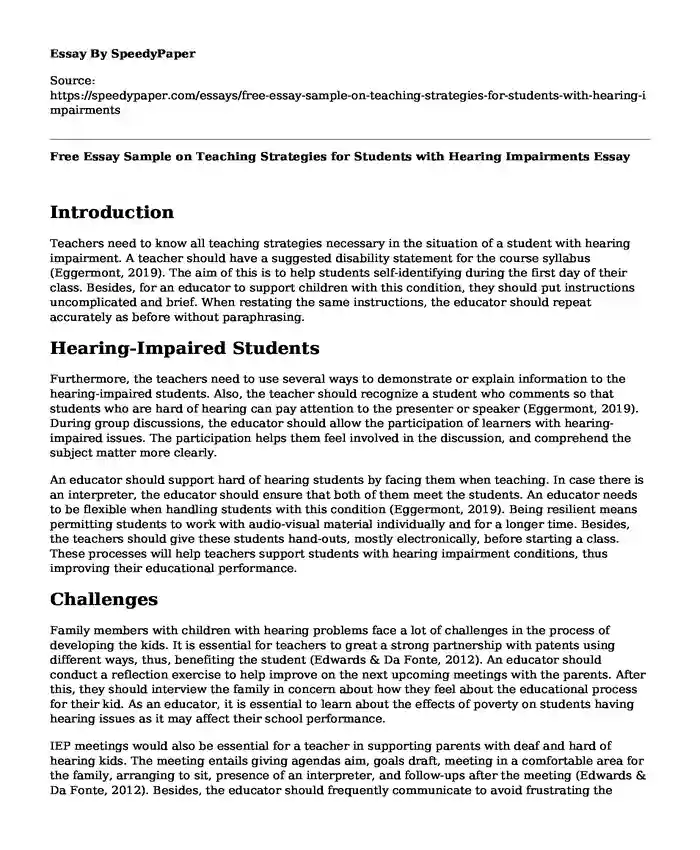Introduction
Teachers need to know all teaching strategies necessary in the situation of a student with hearing impairment. A teacher should have a suggested disability statement for the course syllabus (Eggermont, 2019). The aim of this is to help students self-identifying during the first day of their class. Besides, for an educator to support children with this condition, they should put instructions uncomplicated and brief. When restating the same instructions, the educator should repeat accurately as before without paraphrasing.
Hearing-Impaired Students
Furthermore, the teachers need to use several ways to demonstrate or explain information to the hearing-impaired students. Also, the teacher should recognize a student who comments so that students who are hard of hearing can pay attention to the presenter or speaker (Eggermont, 2019). During group discussions, the educator should allow the participation of learners with hearing-impaired issues. The participation helps them feel involved in the discussion, and comprehend the subject matter more clearly.
An educator should support hard of hearing students by facing them when teaching. In case there is an interpreter, the educator should ensure that both of them meet the students. An educator needs to be flexible when handling students with this condition (Eggermont, 2019). Being resilient means permitting students to work with audio-visual material individually and for a longer time. Besides, the teachers should give these students hand-outs, mostly electronically, before starting a class. These processes will help teachers support students with hearing impairment conditions, thus improving their educational performance.
Challenges
Family members with children with hearing problems face a lot of challenges in the process of developing the kids. It is essential for teachers to great a strong partnership with patents using different ways, thus, benefiting the student (Edwards & Da Fonte, 2012). An educator should conduct a reflection exercise to help improve on the next upcoming meetings with the parents. After this, they should interview the family in concern about how they feel about the educational process for their kid. As an educator, it is essential to learn about the effects of poverty on students having hearing issues as it may affect their school performance.
IEP meetings would also be essential for a teacher in supporting parents with deaf and hard of hearing kids. The meeting entails giving agendas aim, goals draft, meeting in a comfortable area for the family, arranging to sit, presence of an interpreter, and follow-ups after the meeting (Edwards & Da Fonte, 2012). Besides, the educator should frequently communicate to avoid frustrating the parents due to a lack of information on their children's progress. It should be easy for the family to get involved in school activities, voluntary activities, and joining PTA. The family members should have evidence-based practices to assure them of the benefits of their disabled children having education (Bell & Nicolai, 2017). Teachers should respect each family's culture and always stay ahead of their parents by thinking beyond. Finally, the educator should refer parents to support groups. Some professional organizations like Down Syndrome Society offer help groups for families like those with hard hearing children.
Conclusion
In educating students with hearing impairment, teachers should keep in mind particular professional and ethical considerations. Teachers should not stand to inform of a light source to avoid shadows, which makes it hard for students to speech read them. The educator should avoid speaking when the student cannot see their face (Bell & Nicolai, 2017). Also, when using a projector, the teacher should stand on the side, and in case of a PA microphone, it should be kept below the educator's mouth. Besides, educators should be aware of noise levels as noisy environments disrupt learners a lot, particularly those with hearing impairment issues (Hidalgo & Abril, 2018). Finally, in the case of a large class, the children with hearing impairment condition should be given the priority of sitting in the front of the course. Thus, these ethical considerations will, in the long run, help in the improvement of students’ performance and easy adaptability to the school environment.
References
Bell, F., & Nicolai, L. (2017). School psychological practice with deaf and hard-of-hearing students. In Handbook of Australian School Psychology (pp. 613-629). Springer, Cham.
Edwards, C. C., & Da Fonte, A. (2012). The 5-point plan: Fostering successful partnerships with families of students with disabilities. Teaching Exceptional Children, 44(3), 6-13.
https://doi.org/10.1177/004005991204400301
Eggermont, J. J. (2019). The Auditory Brain and Age-related Hearing Impairment. Academic Press.
Hidalgo, F. J. P., & Abril, C. A. H. (2018). Curricular and instructional considerations for teaching EFL to deaf and hard-of-hearing students. In Nuevas perspectivas en educación bilingüe: investigación e innovación (pp. 315-320). Universidad de Granada.
Cite this page
Free Essay Sample on Teaching Strategies for Students with Hearing Impairments. (2023, Nov 08). Retrieved from https://speedypaper.com/essays/free-essay-sample-on-teaching-strategies-for-students-with-hearing-impairments
Request Removal
If you are the original author of this essay and no longer wish to have it published on the SpeedyPaper website, please click below to request its removal:
- How to Critically Analyse an Article - Essay Samples
- A Comparison of Individual and Team Learning - Literature Review Paper Sample
- Essay Sample on College Student Suicide
- Free Essay Example on Formalism Literary Theory
- Essay Example: On the Politics of Empirical Audience Research
- Free Essay Example - Case Study USTA
- Beyond Ethnic Boundaries: Hard Work as the Universal Key to Academic Success - Free Report Example
Popular categories





